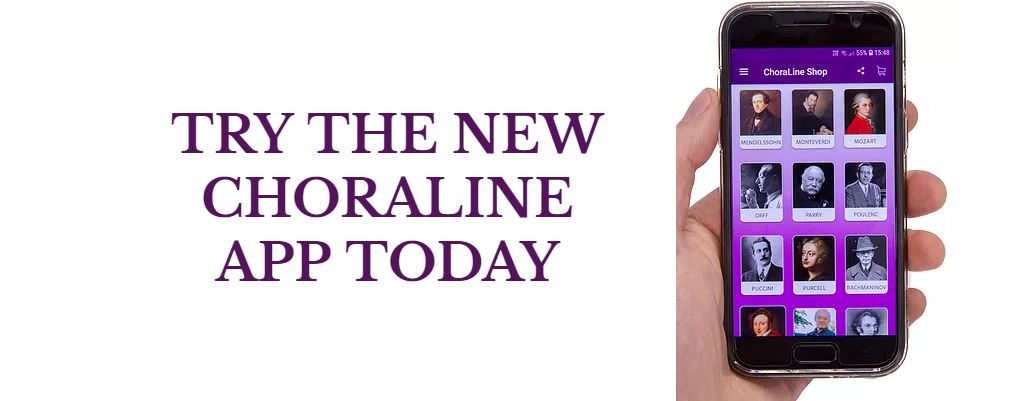Singing Suggestions
The ChoraLine team have made a list of pieces which you may wish to consider singing at your next concert
We have tried to include a wide range of music which you may not have considered before, all of which have ChoraLine SATB voice part rehearsal CDs and MP3 downloads available.
Finzi – Intimations of Immortality [for tenor soloist, chorus and orchestra]
Finzi’s music is often filled with an awareness of the frailty of life, and this setting of a text by Wordsworth is a moving evocation of the passing of childhood and its innocence. Musically it bears similarities to Bliss and Vaughan Williams, and sits squarely within the pastoral tradition of the English Romantic school.
Chilcott – Jubilate [for soprano or tenor soloist, chorus and brass ensemble/piano]
By turns broadly grandiose and exuberantly playful (evoking the more boisterous works of Rutter), Chilcott’s English-language setting of Psalm 100 also has quieter, more intimate moments for both chorus and soloist. Interestingly, and unusually for settings of this Psalm, it ends in awed stillness rather than with a triumphant shout.
Chilcott – Requiem [for soprano and tenor soloists, chorus and orchestra/small ensemble]
Solemn yet uplifting, this is a piece filled with reassurance and hope. From the opening, heartbeat-like motif (reminiscent of the Brahms Requiem) that permeates every movement, through the tumults of the Dies Irae and a haunting, weightless Pie Jesu, Chilcott’s approachable style is always to the fore. It is testament to his skill that even with so many Requiems already in existence, Chilcott has nevertheless managed to find something new to say in this genre.
Mahler – Symphony No. 2 [for soprano and alto soloists, chorus and large orchestra]
2011 sees the 100th anniversary of Mahler’s death, and his “Resurrection” Symphony seems a fitting tribute for choirs looking to mark the occasion. As in Beethoven’s 9th, the chorus is saved for the last movement of this work, where it adds even greater intensity to the climax of an already emotionally charged piece. Entering in a hushed whisper, the chorus supplements the soloists’ exhortations to the soul before joining them in a thrilling finale promising eternal life.
Tippett – A Child of Our Time [for soprano, alto, tenor and bass soloists, chorus and orchestra]
Composed in the early years of the Second World War, this is a dark work centred on the story of Herschel Grynszpan, a Jewish refugee whose murder of a German diplomat was used as the excuse for Kristallnacht. Tippett punctuates the work with American spirituals in a similar manner to Bach’s use of chorales in his Passions. With the tenth anniversary of the World Trade Centre attacks falling in September 2011, this modern meditation on injustice and terror is as relevant today as the day it was written.
Elgar – The Spirit of England Op. 80 [for tenor or soprano soloist, chorus and
orchestra]
It is true that Elgar is closely associated with Edwardian pomp and jingoism , but his rather ambiguously-titled ‘Spirit of England’, completed in 1917, is actually a sensitive and moving commemoration for the victims of war. It is also a masterly piece of choral and orchestral writing and as such deserves much wider appreciation. In this emotive setting of several texts from Laurence Binyon’s collection of war poems ‘The Winnowing Fan’, Elgar’s personal anguish is poignantly captured in the work’s last movement ‘For the Fallen’; his powerful setting of the words ‘there is music in the midst of desolation’ demonstrating the intensity of his choral and orchestral writing.
Stravinsky – Symphony of Psalms [for choir and small orchestra]
Written during Stravinsky’s Neoclassical phase, ‘Symphony of Psalms’ is essentially a three-movement choral symphony utilising a number of popular psalm texts. Stravinsky intended a childrens choir to sing the upper voice parts, but many performances substitute his original arrangements for a mixed voice choir. Stravinsky’s exquisite orchestration demonstrates his aptitude for fugue and counterpoint, intended to evoke church music from the Renaissance and Baroque periods. The orchestra omits clarinets, violins and violas.
Gilbert & Sullivan – Trial by Jury [for soprano, tenor, two baritones, bass-baritone and bass soloists, chorus and orchestra/piano]
Trial by Jury is one of Gilbert and Sullivan’s most well known and popular comic operas. An opera in one act, it could make the perfect addition to a Summer concert. Based on a ‘breach of promise of marriage’ lawsuit, Trial by Jury pokes fun at the legal system with a list of ridiculous, but recognisable, characters, such as an incompetent but very ‘learned’ judge.
Gilbert and Sullivan – The Mikado [for soprano, two mezzo-sopranos, alto, tenor, three baritones, bass-baritone and bass soloists, chorus and orchestra]
Set in exotic Japan in the fictional town of Titipu, The Mikado is a comic opera in two acts boasting an array of rather silly characters such as Nanki-Poo, the opera’s hero, Yum-Yum the attractive love interest and Pish-Tush the noble lord. Including the well-known numbers ‘Three little maids from school are we’ and ‘On a tree by a river’, The Mikado remains the most frequently performed opera at the Savoy.
Poulenc – Stabat Mater [for soprano soloist, choir and orchestra]
Composed in response to the death of his friend Christian Berard, Poulenc’s Stabat Mater was premiered in 1951 at the Strasbourg Festival. A challenging work scored for mixed choir and orchestra, this work won the New York Critics’ Circle Award for Best Choral Work of that year. Stylistically it is far removed from the idiosyncratic high spirits that characterise Poulenc’s earlier and better-known works; following a religious experience at Rocamadour the composer entered a refined phase of intensely Catholic compositions, of which this is a prime example.





